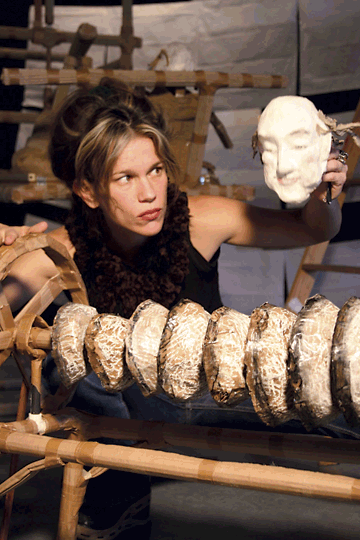
When Sebastienne Mundheim C’90 FA’90 reflects on her current multi-media stage performance, Currently Franklin: The Story of a Paperboy, she points out that she began as a visual artist. After learning to create images through sculpture, she found that she was often moved to transform those images into stories. Now her concepts for the stage begin with her visual inspirations.
“At some point an image strikes me, and it becomes something that I really want to create for the stage,” she explains. “And at the same time, a lesson comes to me, and I want to tell a story.”
Currently Franklin, which brings the ambition and lessons of Benjamin Franklin to the stage, employs physical-theater performers and a variety of props to bring the legend to life. It recently completed a successful run at the Rotunda Theater on Penn’s campus.
When she was first commissioned by Franklin and Marshall College to create the piece, Mundheim perceived Franklin as a “playful, calculating choreographer … one who had the interest and restraint to orchestrate various situations, whether they were scientific experiments or political scenarios.”
Though the piece eventually integrated a significant amount of voice-over narration, Mundheim’s “first desire was to make a piece that was about sculpture and dance,” she says. “I considered how much narrative I could use and still have the visual experience hold equal weight.”
Further inspiration came in the form of paper designs, which comprise a large portion of the set. A paper-covered backdrop doubles as a screen for shadow images. The set design also ties into the theme of Franklin’s tenure as a printer and his “current” of ideas.
To avoid the traditional representations, her offbeat puppets of Franklin—which represent him at different stages of his life—move our conception of the legendary icon into new territory. Those moving images, somewhere between expressionistic and surreal, invigorate Franklin for youthful audiences.
Mundheim originally intended to leave out any physical representation of Franklin and make use only of symbolic references, such as giant shoes and leather aprons to depict his “Junto” club. But one day, while developing sculptures to be used as props, she found herself constructing a puppet of Franklin and realized that it fit right into her approach.
Mundheim’s actors use movement performance to integrate her sculptures into the drama. To depict Franklin’s youthful flight from Massachusetts, a large skeletal prop becomes the ship on which the ever-investigating young Franklin travels to New York. The structure rocks on the shoulders of a performer who, throughout the show, shifts positions as fast as the breezy narration calls for a new scenario.
While her performers double in dance movement and puppeteering, often incorporating props and acting out scenarios, Mundheim narrates the story and operates the music program from stage left.
Through her avant-garde approach, Mundheim aims to promote art in education. “People think that if something is educational, it’s not really art,” she says. “Or, if it’s an artistic thing, it doesn’t really teach that much. I’m trying to promote ‘visual thinking’ and connect it with rational, language-based thinking. That’s what makes this approach so relevant.”
—Matthew Sorrento




